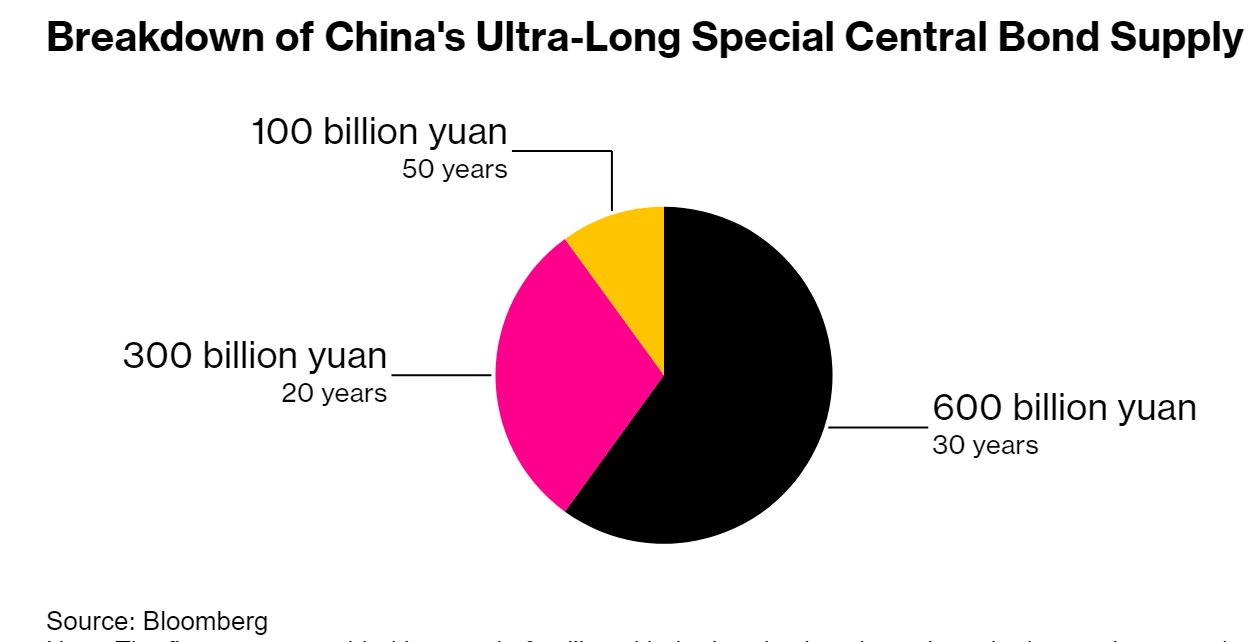From China to India
This week we focus on China's selling of bonds to boost economy & how it became India's largest trading partner. India seeing investor inflow while boosting its solar power capacities
China to sell sovereign bonds to boost economy
China is set to begin selling the inaugural portion of its 1 trillion yuan ($138 billion) ultra-long special sovereign bonds.
This initiative aims to bolster fiscal support as the nation grapples with challenges from a housing market crisis and declining consumer confidence.
The government intends to allocate funds from these bonds towards infrastructure projects, which are crucial for achieving an annual growth target of approximately 5%, surpassing economists' predictions.
The timing of this bond issuance appears strategically planned to counterbalance the effects of the protectionist tariffs that the United States is threatening to impose on Chinese goods.
Inflow of investors in India’s bond market
Global investors are increasingly targeting India’s $1 trillion sovereign bond market as the country prepares for its inclusion in global debt indexes. This shift offers a compelling opportunity for overseas investors to invest in rupee-denominated Indian government debt, which currently boasts some of the highest returns among emerging markets.
JPMorgan is set to benefit from this move, particularly after excluding Russia from its indexes and amid ongoing US-China geopolitical tensions.
When JPMorgan announced India’s inclusion last September, it noted that 23 bonds with a combined notional value of approximately $330 billion would qualify for its Emerging Markets (EM) index.
Additionally, India has been under consideration for inclusion in FTSE Russell’s EM debt index since March 2021.
This development allows investors to diversify their portfolios by allocating funds to a high-yield market in the world’s fifth-largest economy.
For India, this inclusion represents a significant opportunity to access a larger pool of liquidity to address its growing financial needs.
The inclusion is expected to attract an additional $30 billion in inflows into India’s bond market, which is essential for financing the country’s current account deficit.
However, the Indian government and the Reserve Bank of India (RBI) remain cautious, concerned that increased foreign investment could heighten market volatility. Consequently, the RBI may need to consider the potential reactions of foreign bond investors more heavily in its monetary policy decisions.
China is India’s largest trading partner
In the fiscal year 2023-24, China has become India's largest trading partner, surpassing the United States with a total bilateral trade value of $118.4 billion.
This marks a shift from the previous years when the US held the top spot in 2021-22 and 2022-23, with the latest Indo-US trade standing at $118.3 billion.
India's exports to China saw a significant increase of 8.7%, reaching $16.67 billion.
Key sectors contributing to this growth included iron ore, cotton yarn, fabrics, handloom products, spices, fruits and vegetables, plastics, and linoleum.
Concurrently, imports from China rose by 3.24%, amounting to $101.7 billion.
Conversely, India's exports to the US experienced a slight decline of 1.32%, falling to $77.5 billion from $78.54 billion in the previous fiscal year.
Imports from the US also saw a notable decrease of approximately 20%, dropping to $40.8 billion.
Historical data from the commerce ministry highlights that China was India's leading trading partner from 2013-14 to 2017-18 and again in 2020-21.
Before China, the UAE held the top position. This reestablishes China's role as India's primary trading partner, a position it now regains from the US.
India became 3rd largest solar power generator in the world
India's swift expansion in solar energy has propelled the nation past Japan, making it the world's third-largest solar power producer in 2023.
Globally, solar energy accounted for a record 5.5 percent of electricity generation in 2023.
Reflecting this trend, India derived 5.8 percent of its electricity from solar power last year.
In 2023, India experienced the fourth-largest increase in solar energy production, adding 18 terawatt-hours (TWh).
This growth was only surpassed by China (+156 TWh), the United States (+33 TWh), and Brazil (+22 TWh).
These four countries collectively contributed 75 percent of the global increase in solar generation for the year.
Furthermore, India aims to triple its renewable energy capacity by 2030.






